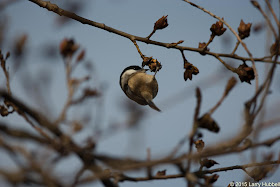If you walk through the Arboretum you are likely to spot a chickadee looking for food while hanging from a twig or a bud. Sometimes the weight of the bird is enough to pull the bud free of the tree.
This bird balanced both itself and its newly liberated cottonwood bud while it mined for food.
I suspect the chickadee is eating a tiny larva, a small bug or a failed little seed. Since chickadees generally weigh less than half an ounce, you can imagine how tiny the minature morsel of food must be.
Cottonwood buds are permeated with a sticky, sap-like goo. In the book "Northwest Trees" by Arno and Hammerly, they say the buds are "...filled with a sticky reddish substance that has a sweet resinous smell, and looks and feels like a mixture of honey and strawberry jam."
Obviously a gooey, sticky bill does not appeal to our little friend. Lacking a napkin, the bird does the next best thing, it wipes its beak on the branch. This habit must have started fairly early in the bird's evolutionary tree as I have seen eagles, owls and even hummingbirds using the exact same technique.
The gooey residue can be seen on the branch just to the right of the bird.
Not everything about a chickadee is obvious or easy to see. For instance, we usually think of chickadees as having black eyes. However, if you look closely you can see that their irises are actually brown and only their pupils are black.
Another surprise for me was when I learned that a chickadee's song is very different than its call. Their songs sound like, "Fee, Be." The first note is about a fourth higher and two or three times longer than the second note. To hear the sound click on the phrase, All About Birds, then scroll down and select the audio link entitled, "Typical Song."
All About Birds also mentions that, "Flocks have many calls with specific meanings, and they may contain some of the characteristics of human language."
During the fall, chickadees cache food to help them make it through the winter.
Surprisingly, they store each saved item in a different location. Apparently, the birds in colder climates need more food and therefore more storage locations. The Birds of North America explained all this and then went on to say that scientists have discovered that chickadees in Alaska have larger hippocampus regions that than their family members in more southern states. (Please see the citation below - Thank you, Martin) Apparently, the increased spatial capacity helps them remember where they have stored all their food. I wonder if this means that chickadees who reside on Mt. Rainer are smarter than the ones that live in Seattle.
This year I have watched chickadees finding seeds in hornbeams...
...and in spruce trees...
...but so far I have never noticed them caching their food. The birds have a vested interest in making sure that they are not seen while hiding their winter supplies. If I pay close attention maybe someday I will get to photograph the process. Nature is amazingly rich in behaviors, diversity and colors. Luckily, even with chickadees, not everything is in black and white.
Have a great day on Union Bay...where nature lives in the city!
Larry
Silhouette Challenge:
Can you determine what type of bird this is? The answer will be in next week's post.
This photo from last week shows an American Robin. As I looked closely at this silhouette, I realized that I was not sure I could see a difference between the outline of...
...the outline of a varied thrush. They are both local birds. They are both part of the thrush family, they are very similar in size, they both like small fruit and their beaks are very similar in shape.
The only differences I could find, after looking at hundreds of photos, has to do with the top of the head. The top of a thrush's head is always perfectly smooth and rounded. In the photo of the robin you can see the slightest disruption in the line of the head and more of a peaked shape on the top. Granted these are very minute differences, so if you guessed either one of these two birds, give yourself full credit for a correct answer.
This time of year if you happen to see a flock of robins eating berries or small fruit. Stop and look closely. Every so often, I find that a few of the most shy "robins" turn out to be varied thrush.
Citation:
Foote, Jennifer R., Daniel J. Mennill, Laurene M. Ratcliffe and Susan M. Smith. 2010. Black-capped Chickadee (Poecile atricapillus), The Birds of North America Online (A. Poole, Ed.). Ithaca: Cornell Lab of Ornithology; Retrieved from the Birds of North America Online: http://bna.birds.cornell.edu/bna/species/039
















Very keen observations about these birds I too often dismiss as common while looking for something else. More than once I've photographed a Robin's silhouette from a distance, thinking it was something I'd never seen before, only to discover it was an old and familiar friend. Our forest setting is full of Chickadees. It's fascinating that the flocks have calls that approach human language. And your documentation of feeding behavior is outstanding and educational. A very enjoyable post today.
ReplyDeleteThank you for your kind and thoughtful comments. The thought that has been on my mind for some time is, What does it mean to be in harmony with nature? I think the answer is in part dependent on our observing and understanding the behaviors of the wild creatures that share the world around us. At least, that seems a logical place to start. Thanks again!
Delete